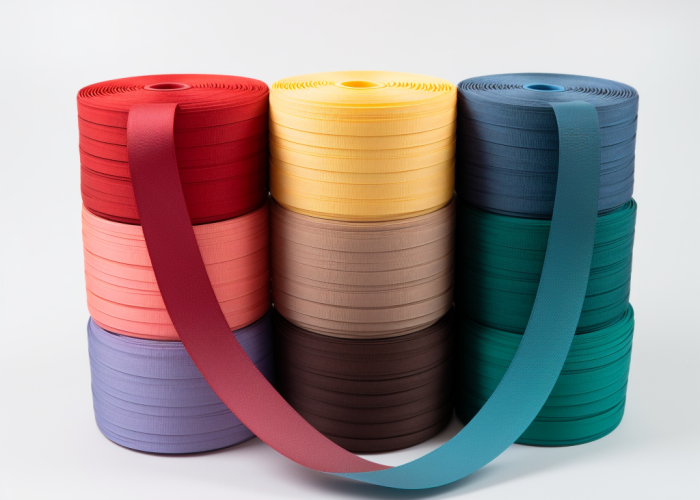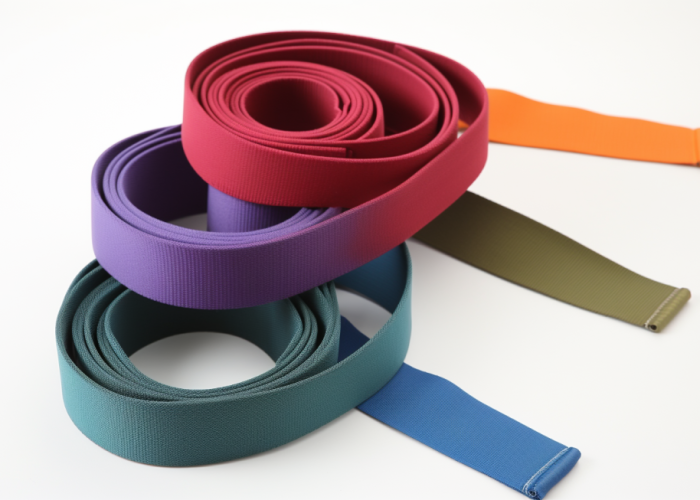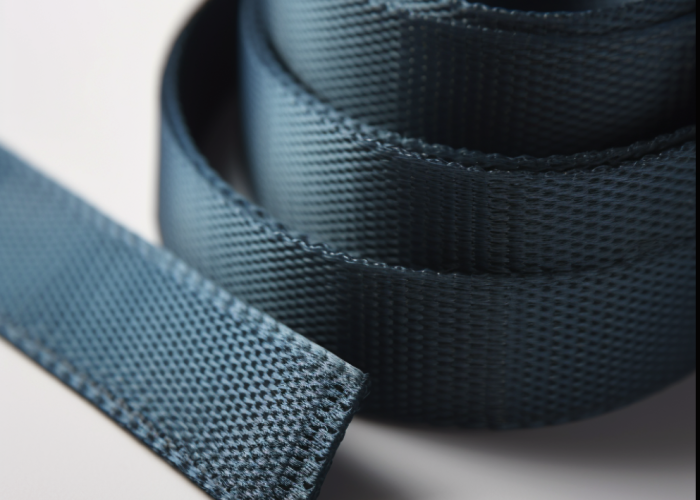Polyester webbing is a durable synthetic material widely used in backpacks, pet harnesses, military equipment, and safety applications. While its strength is beneficial for load-bearing applications, polyester webbing can often be uncomfortably stiff, making it difficult to work with and potentially causing discomfort when in contact with skin.
Polyester webbing can be effectively softened using six reliable methods: boiling in water, washing with vinegar, treating with baking soda, applying commercial softeners, controlled heat treatment, or mechanical manipulation. Each technique offers different benefits and considerations depending on your application requirements, with some methods better preserving structural integrity while others provide more significant softening effects.
Learn how to soften polyester webbing, why it stiffens during manufacturing, and key tips to balance flexibility and strength in your product development.


Webbing manufacturing expert with 15+ years of experience helping product developers build high-performance straps for industrial, medical, and outdoor use.
Polyester webbing becomes stiff primarily due to its essential manufacturing process, which involves chemicals and high heat to transform petroleum-based products into fibers. During this process, the fibers can become tightly packed, resulting in a rigid material that requires softening before use in applications where flexibility is a priority.
The rigidity of polyester webbing is a direct consequence of how it’s manufactured. The manufacturing process creates a dense fiber arrangement at the molecular level that naturally resists bending and flexibility. This stiffness is what gives polyester webbing its impressive tensile strength and durability but can make it challenging to work with in certain applications where comfort and flexibility are equally important.
Industrial-grade polyester webbing is particularly designed to withstand extreme conditions and maintain its structural integrity under heavy loads. This focus on strength often results in a material that feels rigid and unyielding when new. While this characteristic is beneficial for applications requiring minimal stretch, such as safety harnesses or heavy-duty strapping, it can be problematic when the webbing needs to conform to irregular shapes or have a softer feel against skin.
Understanding why polyester webbing develops stiffness is essential for product developers and manufacturers who need to balance the material’s inherent strength with usability requirements. By recognizing that stiffness is a byproduct of the manufacturing process rather than a defect, developers can make informed decisions about appropriate softening techniques for their specific applications.
Polyester webbing stiffness is influenced by fiber content, weave pattern, manufacturing temperature, and finishing treatments. These factors determine the material’s flexibility, with higher density weaves and certain fiber compositions creating stiffer webbing that may require additional processing for applications demanding greater pliability.
The fiber content directly impacts the flexibility of polyester webbing. Higher denier fibers (thicker individual strands) create a more rigid end product, while finer deniers can produce a somewhat more supple feel. The composition of these fibers also matters – some polyester formulations naturally produce a stiffer result than others due to their molecular structure and the manufacturing conditions under which they’re produced.
Weave pattern is equally significant in determining stiffness. Tightly woven patterns with minimal space between threads create more rigid webbing. The file indicates that webbing with higher fiber counts tends to be stiffer than limited varieties. Similarly, a tight, dense weave pattern restricts movement between fibers, resulting in less flexibility overall. This is particularly evident in high-strength webbing designed for critical safety applications where minimal stretch is desired.
Manufacturing temperature plays a crucial role in determining the final stiffness of polyester webbing. The high temperatures used during production can fuse fibers more completely, increasing rigidity. These heat-set fibers maintain their position more firmly, which contributes to the stiff hand-feel of new polyester webbing. This heat-setting is intentional for applications requiring dimensional stability but creates challenges when flexibility is needed.
Finishing treatments applied during manufacturing can either increase or decrease stiffness. Some treatments are specifically designed to add rigidity for particular applications, while others might be applied to provide a degree of softness. These finishing processes often involve chemical applications that coat or penetrate the fibers, altering their surface characteristics and flexibility.
For product developers, understanding these manufacturing and material factors is essential when specifying polyester webbing for particular applications. Recognizing the balance between strength requirements and flexibility needs will help determine which softening methods are most appropriate and whether custom manufacturing specifications might help achieve the desired hand-feel without post-production softening.

The boiling method softens polyester webbing by immersing it in hot water for 5-10 minutes, which relaxes the fiber structure without compromising structural integrity. This technique is particularly effective for stiff webbing that needs softening before installation or use in applications where flexibility is required.
To implement the boiling method effectively, fill a large pot with water and bring it to a boil. Place the polyester webbing completely in the boiling water, ensuring it’s fully submerged. Let it soak for approximately 5-10 minutes, which is generally sufficient time to achieve noticeable softening without damaging the material.
After the soaking period, remove the webbing using tongs or other heat-resistant tools and allow it to cool. The effectiveness of this method stems from how heat temporarily relaxes some of the rigid bonds in the fiber structure. As the webbing cools, these bonds reform, but with slightly more flexibility than before treatment.
This method has proven particularly effective for stiff webbing but works best on material that hasn’t been heavily treated with stiffening agents during manufacturing. The boiling process appears to remove some of the sizing (stiffening agents) from the webbing as mentioned in the file, creating a material that’s more flexible and easier to work with after this treatment.
Product developers should note that while the boiling method is effective, it should be used with caution on dyed or printed webbing as high temperatures may affect colorfastness. Additionally, timing is crucial—extending the boiling period beyond recommended times may risk compromising the structural integrity of the webbing. This method strikes an excellent balance between improved flexibility and maintained strength for most standard polyester webbing applications.
Household methods for softening polyester webbing include vinegar washes and baking soda treatments, which can effectively increase flexibility without specialized equipment. These accessible techniques use common ingredients that gently break down stiffness while preserving the structural integrity of the webbing material.
The vinegar method utilizes acetic acid as a softening agent for polyester. To implement this technique, add one cup of white vinegar to a standard washing cycle instead of detergent. Run the machine for the normal duration of a complete cycle, then dry as you would normally do after the wash. The mild acidity of vinegar helps break up and soften the fibers without causing damage to the material structure.
Baking soda offers an alternative household approach to softening polyester webbing. This method involves adding a half cup of baking soda halfway through the wash cycle. Complete a normal wash cycle, then rinse thoroughly to remove all baking soda residue. Baking soda works as a natural cleaning agent that can cleanse the fibers, neutralize odors, and soften the fabric. Some sources in the file suggest that baking soda may degrade polyester if used sparingly, so careful application and thorough rinsing are essential.
Both methods are particularly useful for product developers working with small batches or prototype designs who may not have access to industrial softening equipment. They provide cost-effective solutions for testing how different flexibility levels affect product performance before committing to large-scale manufacturing processes.
For optimal results, these household methods may need to be repeated several times to achieve the desired level of softness, especially for industrial-grade webbing with high stiffness levels. Product developers should always test these methods on small samples before treating entire production runs to ensure the desired balance between softness and strength is maintained.

Commercial softeners and controlled heat treatments offer professional-grade options for softening polyester webbing in manufacturing environments. Specialized fabric softeners designed specifically for synthetic materials use olfactory-active compounds to soften polyester, while precise temperature control between 50-60°C (122-140°F) for 5-10 minutes can effectively increase flexibility without damaging the material.
Commercial fabric softeners formulated specifically for synthetic materials contain compounds that interact with polyester fibers at the molecular level. These specialized softeners are developed specifically for synthetic fibers and may provide more consistent results than household alternatives. The file indicates these commercial treatments are particularly effective when polyester webbing requires softening while maintaining its full structural properties.
Heat treatment offers a physical approach to softening without chemical additives. The optimal temperature range for softening polyester webbing is precisely 50-60°C (122-140°F) maintained for 5-10 minutes. This controlled heating process needs to remain below the material’s heat deflection point of 80°C (176°F) to avoid permanent damage. The file specifically warns that exceeding these temperature guidelines risks permanently damaging the webbing and compromising its strength.
For manufacturing environments, these methods offer scalable solutions that can be integrated into production processes. Heat chambers with precise temperature control can process large quantities of webbing consistently, while specialized chemical treatments can be applied through industrial washing systems. Both approaches allow manufacturers to deliver polyester webbing with customized flexibility characteristics to meet specific client requirements.
When implementing these commercial methods, it’s critical to maintain consistent temperature and chemical concentration. The file emphasizes that polyester has specific temperature thresholds that should not be exceeded, making controlled application essential for preserving material integrity while achieving the desired softening effect.

Mechanical manipulation softens polyester webbing through repeated gentle manipulation that physically breaks down the stiffness in the fibers. This technique involves manually working the material with hands or mechanical tools to gradually increase flexibility without chemical or heat treatments.
The mechanical softening process works by manipulating the webbing repeatedly with hands or appropriate tools. This physical manipulation gradually breaks down the stiffness in the fibers as they are worked back and forth. The file specifically mentions techniques like massaging, crumpling, and working the material manually to achieve the desired flexibility.
For optimal results, the mechanical approach should be consistent and thorough—working across the entire length of the webbing rather than focusing on isolated sections. This ensures even softening throughout the material and prevents areas of inconsistent flexibility that could affect product performance. The file emphasizes the importance of working the entire webbing surface to achieve consistent results.
This method is particularly valuable for product developers working on prototypes or small production runs where investing in chemical treatments or specialized equipment may not be practical. It allows for targeted softening of specific sections of webbing while leaving others at their original stiffness—a level of control that can be difficult to achieve with other methods.
While effective, mechanical manipulation is more labor-intensive than other techniques, making it less suitable for high-volume production. However, for applications requiring precise control over flexibility or for developers working with limited resources, this method offers an accessible approach that requires no special equipment or chemical treatments.
When softening polyester webbing, critical precautions include monitoring temperature, selecting appropriate chemicals, limiting UV exposure, and considering strength requirements. These factors ensure the softening process doesn’t compromise the webbing’s essential performance characteristics or create safety risks in load-bearing applications.
Temperature sensitivity is a primary concern when softening polyester webbing. The file explicitly states that polyester has specific temperature thresholds that should not be exceeded—specifically, treatments should remain below 80°C (176°F), with the optimal range being 50-60°C (122-140°F). Exceeding these temperatures can permanently damage the webbing and compromise its strength. Manufacturers must implement precise temperature controls when using heat treatments to ensure consistent results without material degradation.
Chemical sensitivities must be carefully managed when using softening agents. Polyester responds differently to various chemicals at different temperature and exposure levels. The file notes that polyester has good resistance to most aqueous solutions at normal ambient temperatures but is degraded by the same solutions at boiling temperatures. Additionally, reactions to alcohols, cleaning solvents, and synthetic detergents can vary significantly. Product developers should test chemical treatments on samples before full-scale application to verify compatibility.
UV exposure presents another risk factor during the softening process. The file warns that excessive direct polyester webbing is notoriously sensitive to ultraviolet light, which can significantly affect its strength. Prolonged sun exposure will gradually break down the polymer structure, resulting in reduced tensile strength and increased brittleness. Signs of UV degradation include bleaching of color, increased stiffness, and the appearance of abrasion or small cracks. Softening processes should therefore be conducted away from direct sunlight whenever possible.
Strength considerations represent perhaps the most critical precaution for product developers. The file emphasizes that when softening polyester webbing used for load-bearing applications, it’s crucial to ensure that the softening process doesn’t compromise the material’s strength. Every softening method has some potential impact on structural integrity, so the selection of an appropriate technique should be guided by the critical performance requirements of the final application. For applications where strength is paramount, more conservative softening methods or specialized webbing that balances strength with inherent flexibility may be preferable.
By carefully addressing these precautions, manufacturers and product developers can successfully implement softening techniques that enhance material handling and comfort without sacrificing the essential performance characteristics that make polyester webbing valuable for demanding applications.

Softening polyester webbing significantly improves its handling characteristics and comfort without compromising structural integrity when proper techniques are applied. Whether using household methods for small batches or industrial processes for large production runs, the key is balancing flexibility with strength requirements. As a custom webbing manufacturer, we can produce polyester webbing with tailored flexibility characteristics to meet your specific product development needs.
Natural alternatives for softening polyester webbing include vinegar, baking soda, and mechanical manipulation. These methods provide chemical-free options for increasing flexibility without specialized equipment or synthetic compounds. For product applications requiring eco-friendly manufacturing processes, these natural approaches offer effective solutions that maintain material integrity.
The most effective household items for softening polyester webbing are white vinegar and baking soda. Vinegar works as a mild acid that helps relax fibers when added to a washing machine cycle, while baking soda acts as a natural cleaning agent that can increase flexibility when properly applied during washing.
Fabric softeners can safely soften polyester webbing when used correctly, but improper application may affect structural integrity. Standard household softeners used sparingly typically won’t damage polyester, but specialized commercial softeners designed specifically for synthetic materials provide more predictable results without compromising strength properties for critical applications.
Softening polyester webbing can reduce tensile strength by 10-15% if excessive methods are applied. Proper softening techniques balance flexibility gains with strength retention, making it crucial to match the softening method with application requirements. For load-bearing applications, manufacturers should select appropriate softening methods that preserve essential structural properties while improving handling characteristics.
Fiber content and weave significantly influence polyester webbing stiffness, with denser weaves and higher denier fibers creating stiffer materials. Webbing with higher thread counts and tighter weaving patterns naturally resists bending and flexing. The fiber diameter and construction technique directly affect how the material responds to forces and its initial flexibility out of production.
The manufacturing process affects polyester webbing stiffness through high heat application and fiber compression during production. As fibers become tightly packed during manufacturing, they create a dense material structure with limited flexibility. The chemical treatments and heat-setting techniques used during production directly determine the initial rigidity level of the finished webbing.